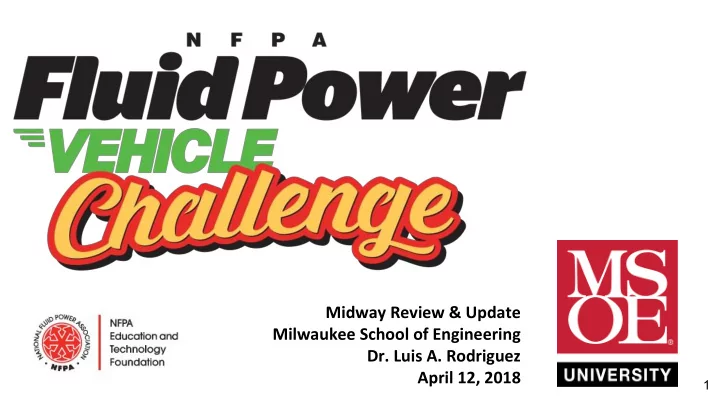

Midway Review & Update Milwaukee School of Engineering Dr. Luis A. Rodriguez April 12, 2018 1
Table of Contents Introductions………………………………………………………………………………………………………………………….3 Problem Statement and Design Objectives…….…………………………………………………………………………………4 Target Specifications………………………………………………………………………………………………………………...5 Research……………………………………………………………………………………………………………………………...6 Frame Selection……………………………………………………………………………………………………………………...7 Fluid Power Circuit Design………………………………………………………………………………………………………….8 Design Formulas……………………………………………………………………………………………………………………..9 Selection of Hardware..…………………………………………………………………………………………………………….11 Manifold……………………………………………………………………………………………………………………………...12 Simulink Model……………………………………………………………………………………………………………………...14 Finite Element Analysis…………………………………………………………………………………………………………….16 Virtual Prototype…………………………………………………………………………………………………………………….18 Manufacturing...................................................................................................................................................................19 Data Acquisition................................................................................................................................................................20 Lessons Learned……………………………………………………………………………………………………………………21 2
Introduction From Left to Right: Nick Herche, Chris Gloeckle, Paul Stran, Rob Lancaster, Juan Casiano 3
Problem Statement and Design Objectives Problem Statement: ● Design and build a human powered vehicle that uses fluid power to transfer and store energy Design Objectives: ● Integrated Design ● Simple Design ● Develop a competitive vehicle that is capable of placing in the top three designs for all events ● Reduce weight and complexity from previous team’s design ● Improve the ease of how the rider operates and enters the vehicle ● Allow for a system that can be readily modified for future Senior Design teams to improve upon 4
Target Specifications Sprint Race ● Achieve top speed of 25 MPH. ● Complete a 600ft course in less than 30 seconds ● Be able to pump the system to working pressure in less than 10 minutes Efficiency Challenge ● Obtain efficiency challenge number no smaller than 150 ● Achieve a system efficiency of 80 % Endurance Race ● Complete the entire race in under 4 minutes ● Be able to maneuver and turn easily ● Must be reliable enough to finish entire endurance course without needing any repairs during the event Figure 1 Danfoss Track 5
Research ● Hydraulic Components ● Hydraulic Systems ● FPVC Designs ○ Includes other teams and previous MSOE team ● Regenerative Braking Figure 2 MSOE Fluid Bike Design from 2013 Figure 3 Regenerative Braking System 6
Frame Selection Table 1 Vehicle Frame Selection Matrix Figure 4 Selected Vehicle Frame 7
Fluid Power Circuit Design CXAA - Check Valve DLDM - 2W2P Valve NCBB - Check/Choke Valve NFBC - Needle Valve RDBA - Pressure Relief Valve Figure 5 Annotated Hydraulic Circuit 8
Design Formulas 9
Table 2 Motor System Displacement 10
Selection of Hardware ● Zwei Inc. ○ Displacement 7 cc/rev ● Parker Hannifin 1L Gas Piston Accumulator ○ 4000 psi Capacity ● 2 Port 2 Way Rotary Valve ● Aluminum Reservoir ○ Weight Reduction 1.66lb vs. 4.92lb Figure 6 Parker Hannifin Accumulators ○ Heat Dissipation Figure 7 Aluminum Reservoir 11
Manifold Circuit CXAA - Check Valve DLDM - 2W2P Valve NCBB - Check/Choke Valve NFBC - Needle Valve RDBA - Pressure Relief Valve Figure 8 Hydraulic Circuit Sent to Sun Hydraulics 12
Manifold Figure 10 Manifold Figure 9 Manifold CAD with Annotations Figure 11 Manifold Motor, Pump, and Accumulator Ports 13
Simulink Circuit Model 14 Figure 12 Simscape Model
Simulink (Cont.) 15 Figure 13 Block Parameters Figure 14 System Response
Finite Element Analysis Figure 15 Sprocket Figure 16 Accumulator Mount 16 Figure 17 Motor Mount Figure 18 Pump Mount
FEA on Motor Figure 19 Motor Mount Revision and Final Implementation 17
Virtual Prototype Figure 21 Isometric View Figure 20 Side View 18
Manufacturing ● Materials ○ A36 ○ 1018 ○ 1020 - 1026 ○ 6061 ● Processes ○ CNC ○ Milling ○ Welding ○ Turning Figure 22 Frame and Components Figure 23 Pump Test Fit 19
Data Acquisition • Reed Switch • Arduino Uno • SD Card Shield • Sampling at 1 KHz • Verified Velocity Data Figure 25 Sample Test Results Figure 24 Arduino 20
Lessons Learned ● Tolerances ○ Leave room for tubing and fittings ● Replacement parts ○ Make sure parts are easily acquired ● Hydraulic nuances, not just high level stuff ○ Learn Rules of Thumb early ● Time Management ○ Leave time for mistakes and problems 21
Questions? 22
Recommend
More recommend